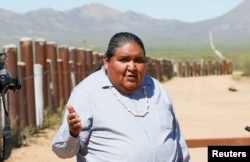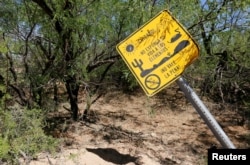Ever since he can remember, Richard Saunders has seen families cross the fence on his Native American reservation in southern Arizona, where the U.S.-Mexican border splits his tribe's land in two, to seek work, see a doctor or go to school.
Laborers from Mexico would stop by his grandfather's house on the U.S. side of the reservation, the ancestral home of the Tohono O'odham nation, which today is marked off by a barrier of loosely spaced metal bars designed to block vehicles between the two nations.
"He'd stand out there and converse with them, take a shot of tequila. Grandma would make them some burritos, and they'd be on their way," recalled Saunders, a senior figure in the nation's administration, heading its public safety department.
But Saunders and other nation members fear U.S. President Donald Trump's plan to sever their land with a border wall will be no different to slicing through their culture and their community.
"If I was to walk into your home and build a wall right in the middle of your house, how would you like that?" said Verlon Jose, vice chairman of the Tohono O'odham, whose name means "Desert People."
"Over my dead body will this happen," Jose told the Thomson Reuters Foundation.
For more than a century, the Tohono O'odham - like other Native Americans - have seen their ancestral lands shrink as a result of hundreds of broken land deals with the U.S. government in its westward expansion in the 1800s.
Of the 2,200-mile (3,500-km) border wall that Trump says will stop drugs, crime and rapists from Mexico, 62 miles (100 km) would run through Tohono O'odham land, putting most of the reservation, which is slightly larger than Lebanon, in the United States and a smaller piece in Mexico's Sonora state.
For now, the border barrier, with three gates for the American Indians to use, zig-zags around cactus, river beds and ancient burial sites, letting through the desert's jaguar, deer, pig-like javelinas, venomous Gila monster lizards and poisonous sidewinder snakes.
Francine Jose, 50, a cousin to the tribe's vice chairman, lives about four miles from the border. About 10,000 people live north of the border, where the schools, commerce and services are located, and another 2,000 live on the Mexican side.
"I think about the Berlin Wall," she told the Thomson Reuters Foundation. "Why do we have to hate or be mad at the country next to us?"
Opposition
The Tohono O'odham's government has not ruled out a high-profile protest similar to one which began last August in the Standing Rock Sioux Reservation, where activists camped for months in opposition to a proposed oil pipeline in North Dakota.
At its height, thousands of protesters gathered at Standing Rock, and more than 700 were arrested. The protest ended after efforts to stop the pipeline lost in court.
"It could turn into that," said Jose, 50. "If we're to see bulldozers start to come in, we will not be standing alone."
However, he is encouraged by Department of Homeland Security Secretary John Kelly, who recently said it was "unlikely that we will build a wall or physical barrier from sea to shining sea."
A suggestion by Department of Interior Secretary Ryan Zinke that electronic monitors may be used in some sections has also helped to allay concerns.
Tribal leaders say the border could be best protected with high-powered surveillance cameras, better access roads and more personnel.
The harsh desert itself, with no year-round sources of running water, is an effective deterrent. Once across the border, the nearest main roads lie 20 miles north.
Last year, the bodies of 85 migrants were found on the reservation compared with 16 so far this year, significantly down from years when more than 100 were found, Saunders said.
Even though barbed wire along the border was replaced by the sturdier vehicle barrier in 2006 - in response to the rise of Mexican drug-smuggling cartels and security fears following the 9/11 attacks - evidence of stealthy crossings is easy to spot.
Drug traffickers leave behind cloth slippers with carpeted soles, used to obliterate their footprints.
Abandoned black plastic water jugs are strewn amid the towering Saguaro cactus, poignant signs of thirst that can kill in the desert where summer temperatures are typically well above 100 degrees Fahrenheit (38 Celsius).
Crisscrossed with dry stream beds, or washes, that flood during the violent summer monsoon season, the landscape burns under a relentless sun. Turkey vultures circle, and a few longhorn cattle huddle under the mesquite trees.
Broken Treaty?
Tohono O'odham was under Mexican jurisdiction before its modern borders around 2.8 million acres (1.13 million hectares) of territory were laid out in a 19th century land deal between the neighboring nations.
Under U.S. law, Native American reservations are sovereign nations that govern themselves, and building a border wall through Tohono O'odham land would amount to a treaty being broken by the U.S. government, said Carlos Veléz-Ibáñez, Regents' Professor and Founding Director Emeritus of the School of Transborder Studies at Arizona State University.
"Indigenous populations on their land have treaty rights, and they're treated as nations, and they're recognized as nations," he said. "Trump and Co. would in fact be violating the treaty rights of indigenous nations."
Asked about Arizona Republican Sen. John McCain's position on the reservation wall, McCain's office did not respond. He told CNN the wall was not a "viable" option" and that border security needs technology and drones.
The state's other U.S. Senator, Republican Jeff Flake, said in an email that the most effective border security "might mean a wall in some places or a fence in others, as well as the right combination of manpower and surveillance."
"Arizona communities along the border should be a part of the discussion and planning as they are of the most affected," he wrote.
Tohono O'odham Tribal Police, with nearly 100 officers, work with the U.S. Customs and Border Protection, which has more than 1,000 agents at the reservation, said Saunders.
It's only fitting that the Tohono O'odham, who have hunted, gathered food and grown crops for thousands of years in the region, are caught up in issues of border protection, Jose said.
"It is embedded in our culture to protect. Not to own, but to protect," said Jose. "That is what we are doing."














